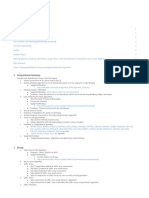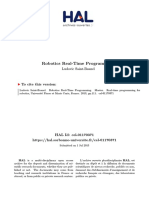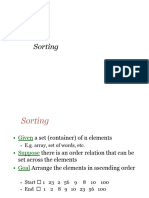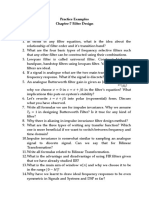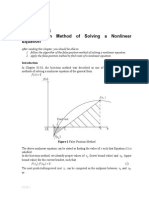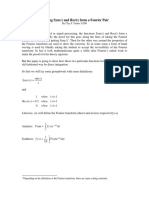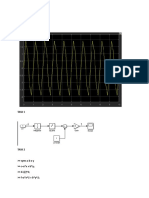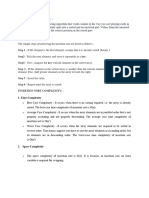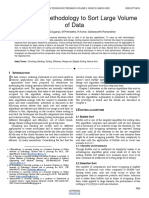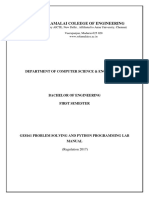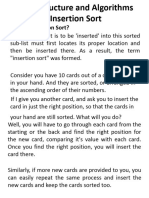See
discussions, stats, and author profiles for this publication at: https://www.researchgate.net/publication/220691201
C++ plus data structures (4. ed.).
Book January 2007
Source: DBLP
CITATIONS
READS
1,265
1 author:
Nell B. Dale
University of Texas at Austin
81 PUBLICATIONS 324 CITATIONS
SEE PROFILE
Available from: Nell B. Dale
Retrieved on: 21 November 2016
�C++ Plus Data Structures
Nell Dale
David Teague
Chapter 10
Sorting and Searching Algorithms
Slides by Sylvia Sorkin, Community College of Baltimore County - Essex Campus
�Sorting means . . .
l
The values stored in an array have
keys of a type for which the relational
operators are defined. (We also
assume unique keys.)
Sorting rearranges the elements into
either ascending or descending order
within the array. (Well use ascending
order.)
2
�Straight Selection Sort
values [ 0 ]
36
[1]
24
[2]
10
[3]
[4]
12
Divides the array into two
parts: already sorted, and
not yet sorted.
On each pass, finds the
smallest of the unsorted
elements, and swaps it into
its correct place, thereby
increasing the number of
sorted elements by one.
3
�Selection Sort: Pass One
values [ 0 ]
36
[1]
24
[2]
10
[3]
[4]
12
U
N
S
O
R
T
E
D
4
�Selection Sort: End Pass One
values [ 0 ]
[1]
24
[2]
10
[3]
[4]
36
12
SORTED
U
N
S
O
R
T
E
D
5
�Selection Sort: Pass Two
values [ 0 ]
[1]
24
[2]
10
[3]
[4]
36
12
SORTED
U
N
S
O
R
T
E
D
6
�Selection Sort: End Pass Two
values [ 0 ]
[1]
6
10
[2]
24
[3]
36
[4]
SORTED
12
U
N
S
O
R
T
E
D
7
�Selection Sort: Pass Three
values [ 0 ]
[1]
6
10
[2]
24
[3]
36
[4]
SORTED
12
U
N
S
O
R
T
E
D
8
�Selection Sort: End Pass Three
values [ 0 ]
[1]
10
[2]
12
[3]
36
[4]
S
O
R
T
E
D
UNSORTED
24
9
�Selection Sort: Pass Four
values [ 0 ]
[1]
10
[2]
12
[3]
36
[4]
S
O
R
T
E
D
UNSORTED
24
10
�Selection Sort: End Pass Four
values [ 0 ]
[1]
10
[2]
12
[3]
24
[4]
S
O
R
T
E
D
36
11
�Selection Sort:
How many comparisons?
values [ 0 ]
4 compares for values[0]
[1]
10
3 compares for values[1]
[2]
12
2 compares for values[2]
[3]
24
1 compare for values[3]
36
= 4 + 3 + 2 + 1
[4]
12
�For selection sort in general
l
The number of comparisons when the
array contains N elements is
Sum = (N-1) + (N-2) + . . . + 2 + 1
13
�Notice that . . .
Sum = (N-1) + (N-2) + . . . +
+ Sum =
+ . . . + (N-2) + (N-1)
2* Sum =
+ ...
2 * Sum =
N * (N-1)
Sum =
N * (N-1)
2
+ N
14
�For selection sort in general
l
The number of comparisons when the
array contains N elements is
Sum = (N-1) + (N-2) + . . . + 2 + 1
Sum = N * (N-1) /2
Sum = .5 N 2 - .5 N
Sum = O(N 2)
15
�template <class ItemType >
int MinIndex ( ItemType values [ ] , int start , int end )
// Post: Function value = index of the smallest value in
//
values [start] . . values [end].
{
int indexOfMin = start ;
for ( int index = start + 1 ; index <= end ; index++ )
if ( values [ index ] < values [ indexOfMin ] )
indexOfMin = index ;
return indexOfMin;
}
16
�template <class ItemType >
void SelectionSort ( ItemType values [ ] , int numValues )
// Post: Sorts array values[0 . . numValues-1 ] into ascending
//
order by key
{
int endIndex = numValues - 1 ;
for ( int current = 0 ; current < endIndex ; current++ )
Swap ( values [ current ] ,
values [ MinIndex ( values, current, endIndex ) ] ) ;
}
17
�Bubble Sort
values [ 0 ]
36
[1]
24
[2]
10
[3]
[4]
6
12
Compares neighboring
pairs of array elements,
starting with the last array
element, and swaps
neighbors whenever they
are not in correct order.
On each pass, this causes
the smallest element to
bubble up to its correct
place in the array.
18
�template <class ItemType >
void BubbleUp ( ItemType values [ ] , int start , int end )
// Post: Neighboring elements that were out of order have been
//
swapped between values [start] and values [end],
//
beginning at values [end].
{
for ( int index = end ; index > start ; index-- )
if (values [ index ] < values [ index - 1 ] )
Swap ( values [ index ], values [ index - 1 ] ) ;
}
19
�template <class ItemType >
void BubbleSort ( ItemType values [ ] , int numValues )
// Post: Sorts array values[0 . . numValues-1 ] into ascending
//
order by key
{
int current = 0 ;
while ( current < numValues - 1 )
BubbleUp ( values , current , numValues - 1 ) ;
current++ ;
}
20
�Insertion Sort
values [ 0 ]
36
[1]
24
[2]
10
[3]
[4]
6
12
One by one, each as yet
unsorted array element is
inserted into its proper
place with respect to the
already sorted elements.
On each pass, this causes
the number of already
sorted elements to increase
by one.
21
�Insertion Sort
6 10 24 36
12
Works like someone who
inserts one more card at
a time into a hand of cards
that are already sorted.
To insert 12, we need to
make room for it by moving
first 36 and then 24.
22
�Insertion Sort
6 10 24
36
12
Works like someone who
inserts one more card at
a time into a hand of cards
that are already sorted.
To insert 12, we need to
make room for it by moving
first 36 and then 24.
23
�Insertion Sort
6 10
24 3
6
12
Works like someone who
inserts one more card at
a time into a hand of cards
that are already sorted.
To insert 12, we need to
make room for it by moving
first 36 and then 24.
24
�Insertion Sort
12 24
0
1
6
36
Works like someone who
inserts one more card at
a time into a hand of cards
that are already sorted.
To insert 12, we need to
make room for it by moving
first 36 and then 24.
25
�template <class ItemType >
void InsertItem ( ItemType values [ ] , int start , int end )
// Post: Elements between values [start] and values [end]
//
have been sorted into ascending order by key.
{
bool finished = false ;
int current = end ;
bool moreToSearch = ( current != start ) ;
while ( moreToSearch && !finished )
{
if (values [ current ] < values [ current - 1 ] )
{
Swap ( values [ current ], values [ current - 1 ] ) ;
current-- ;
moreToSearch = ( current != start );
}
else
finished = true ;
}
}
26
�template <class ItemType >
void InsertionSort ( ItemType values [ ] , int numValues )
// Post: Sorts array values[0 . . numValues-1 ] into ascending
//
order by key
{
for ( int count = 0 ; count < numValues ; count++ )
InsertItem ( values , 0 , count ) ;
}
27
�Sorting Algorithms
and Average Case Number of Comparisons
Simple Sorts
n
n
n
Straight Selection Sort
Bubble Sort
Insertion Sort
O(N2)
More Complex Sorts
n
n
n
Quick Sort
Merge Sort
Heap Sort
O(N*log N)
28
�Recall that . . .
A heap is a binary tree that satisfies these
special SHAPE and ORDER properties:
n
Its shape must be a complete binary tree.
For each node in the heap, the value
stored in that node is greater than or
equal to the value in each of its children.
29
�The largest element
in a heap is always found in the root node
root
70
12
60
40
30
10
30
�The heap can be stored
in an array
values
[0]
70
[1]
60
[2]
[3]
root
70
0
12
40
60
12
[4]
30
40
30
10
[5]
[6]
10
31
�Heap Sort Approach
First, make the unsorted array into a heap by
satisfying the order property. Then repeat the
steps below until there are no more unsorted
elements.
l
Take the root (maximum) element off the heap
by swapping it into its correct place in the
array at the end of the unsorted elements.
Reheap the remaining unsorted elements.
(This puts the next-largest element into the
root position).
32
�After creating the original heap
values
[0]
70
[1]
60
[2]
[3]
root
70
0
12
40
60
12
[4]
30
40
30
10
[5]
[6]
10
33
�Swap root element into last place
in unsorted array
values
[0]
70
[1]
60
[2]
[3]
root
70
0
12
40
60
12
[4]
30
40
30
10
[5]
[6]
10
34
�After swapping root element
into its place
values
[0]
10
[1]
60
[2]
[3]
root
10
0
12
40
60
12
[4]
30
40
30
70
[5]
[6]
70
NO NEED TO CONSIDER AGAIN
35
�After reheaping remaining
unsorted elements
values
[0]
60
[1]
40
[2]
[3]
root
60
0
12
10
40
12
[4]
30
10
30
70
[5]
[6]
70
36
�Swap root element into last place
in unsorted array
values
[0]
60
[1]
40
[2]
[3]
root
60
0
12
10
40
12
[4]
30
10
30
70
[5]
[6]
70
37
�After swapping root element
into its place
values
[0]
[1]
40
[2]
[3]
root
8
0
12
10
40
12
[4]
30
10
30
60
70
[5]
60
[6]
70
NO NEED TO CONSIDER AGAIN
38
�After reheaping remaining
unsorted elements
values
[0]
40
[1]
30
[2]
[3]
root
40
0
12
10
30
12
[4]
10
60
70
[5]
60
[6]
70
39
�Swap root element into last place
in unsorted array
values
[0]
40
[1]
30
[2]
[3]
root
40
0
12
10
30
12
[4]
10
60
70
[5]
60
[6]
70
40
�After swapping root element
into its place
values
[0]
[1]
30
[2]
[3]
root
6
0
12
10
30
12
[4]
40
10
40
60
70
[5]
60
[6]
70
NO NEED TO CONSIDER AGAIN
41
�After reheaping remaining
unsorted elements
values
[0]
30
[1]
10
[2]
[3]
root
30
0
12
6
10
12
[4]
40
40
60
70
[5]
60
[6]
70
42
�Swap root element into last place
in unsorted array
values
[0]
30
[1]
10
[2]
[3]
root
30
0
12
6
10
12
[4]
40
40
60
70
[5]
60
[6]
70
43
�After swapping root element
into its place
values
[0]
[1]
10
[2]
[3]
root
6
0
12
30
10
12
[4]
40
30
40
60
70
[5]
60
[6]
70
NO NEED TO CONSIDER AGAIN
44
�After reheaping remaining
unsorted elements
values
[0]
12
[1]
10
[2]
[3]
root
12
0
6
30
10
[4]
40
30
40
60
70
[5]
60
[6]
70
45
�Swap root element into last place
in unsorted array
values
[0]
12
[1]
10
[2]
[3]
root
12
0
6
30
10
[4]
40
30
40
60
70
[5]
60
[6]
70
46
�After swapping root element
into its place
values
[0]
[1]
10
[2]
[3]
root
6
0
12
30
10
12
[4]
40
30
40
60
70
[5]
60
[6]
70
NO NEED TO CONSIDER AGAIN
47
�After reheaping remaining
unsorted elements
values
[0]
10
[1]
[2]
[3]
root
10
0
12
30
12
[4]
40
30
40
60
70
[5]
60
[6]
70
48
�Swap root element into last place
in unsorted array
values
[0]
10
[1]
[2]
[3]
root
10
0
12
30
12
[4]
40
30
40
60
70
[5]
60
[6]
70
49
�After swapping root element
into its place
values
[0]
[1]
10
[2]
[3]
root
6
0
12
30
10
12
[4]
40
30
40
60
70
[5]
60
[6]
70
ALL ELEMENTS ARE SORTED
50
�template <class ItemType >
void HeapSort ( ItemType values [ ] , int numValues )
// Post: Sorts array values[ 0 . . numValues-1 ] into ascending
//
order by key
{
int index ;
// Convert array values[ 0 . . numValues-1 ] into a heap.
for ( index = numValues/2 - 1 ; index >= 0 ; index-- )
ReheapDown ( values , index , numValues - 1 ) ;
// Sort the array.
for ( index = numValues - 1 ; index >= 1 ; index-- )
{
Swap ( values [0] , values [index] );
ReheapDown ( values , 0 , index - 1 ) ;
}
}
51
�ReheapDown
template< class ItemType >
void ReheapDown ( ItemType values [ ], int root, int bottom )
// Pre: root is the index of a node that may violate the heap
//
order property
// Post: Heap order property is restored between root and bottom
{
int maxChild ;
int rightChild ;
int leftChild ;
leftChild = root * 2 + 1 ;
rightChild = root * 2 + 2 ;
52
�if ( leftChild <= bottom )
// ReheapDown continued
{
if ( leftChild == bottom )
maxChild = leftChild;
else
{
if (values [ leftChild ] <= values [ rightChild ] )
maxChild = rightChild ;
else
maxChild = leftChild ;
}
if ( values [ root ] < values [ maxChild ] )
{
Swap ( values [ root ] , values [ maxChild ] ) ;
ReheapDown ( maxChild, bottom ) ;
}
}
}
53
�Heap Sort:
How many comparisons?
In reheap down, an element
is compared with its 2
children (and swapped
with the larger). But
only one element at
each level makes
this comparison,
and a complete
binary tree with
30
N nodes has
3
only O(log2N)
levels.
15
6
7
root
24
0
60
12
2
40
10
18
70
10
54
�Heap Sort of N elements:
How many comparisons?
(N/2) * O(log N) compares to create original heap
(N-1) * O(log N) compares for the sorting loop
= O ( N * log N) compares total
55
�Using quick sort algorithm
A..Z
A..L
A..F
M..Z
G..L
M..R
S..Z
56
�// Recursive quick sort algorithm
template <class ItemType >
void QuickSort ( ItemType values[ ] , int first , int last )
// Pre: first <= last
// Post: Sorts array values[ first . . last ] into ascending order
{
if ( first < last )
// general case
{
int splitPoint ;
Split ( values, first, last, splitPoint ) ;
// values [ first ] . . values[splitPoint - 1 ] <= splitVal
// values [ splitPoint ] = splitVal
// values [ splitPoint + 1 ] . . values[ last ] > splitVal
QuickSort( values, first, splitPoint - 1 ) ;
QuickSort( values, splitPoint + 1, last );
}
};
57
�Before call to function Split
splitVal = 9
GOAL: place splitVal in its proper position with
all values less than or equal to splitVal on its left
and all larger values on its right
9
values[first]
20
18
14
60
11
[last]
58
�After call to function Split
splitVal = 9
smaller values
in left part
larger values
in right part
18
14
20
values[first]
60
11
[last]
splitVal in correct position
59
�Quick Sort of N elements:
How many comparisons?
N
For first call, when each of N elements
is compared to the split value
2 * N/2
For the next pair of calls, when N/2
elements in each half of the original
array are compared to their own split values.
4 * N/4
For the four calls when N/4 elements in each
quarter of original array are compared to
their own split values.
.
.
.
HOW MANY SPLITS CAN OCCUR?
60
�Quick Sort of N elements:
How many splits can occur?
It depends on the order of the original array elements!
If each split divides the subarray approximately in half,
there will be only log2N splits, and QuickSort is
O(N*log2N).
But, if the original array was sorted to begin with, the
recursive calls will split up the array into parts of
unequal length, with one part empty, and the
other part containing all the rest of the array except for
split value itself. In this case, there can be as many as
N-1 splits, and QuickSort is O(N2).
61
�Before call to function Split
splitVal = 9
GOAL: place splitVal in its proper position with
all values less than or equal to splitVal on its left
and all larger values on its right
9
values[first]
20
26
18
14
53
60
11
[last]
62
�After call to function Split
splitVal = 9
no smaller values
empty left part
20
26
larger values
in right part with N-1 elements
18
14
values[first]
53
60
11
[last]
splitVal in correct position
63
�Merge Sort Algorithm
Cut the array in half.
Sort the left half.
Sort the right half.
Merge the two sorted halves into one sorted array.
74
36
...
[first]
36
74
95
75
29
...
[middle] [middle + 1]
...
95
29
52
52
[last]
...
75
64
�// Recursive merge sort algorithm
template <class ItemType >
void MergeSort ( ItemType values[ ] , int first , int last )
// Pre: first <= last
// Post: Array values[ first . . last ] sorted into ascending order.
{
if ( first < last )
// general case
{
int middle = ( first + last ) / 2 ;
MergeSort ( values, first, middle ) ;
MergeSort( values, middle + 1, last ) ;
// now merge two subarrays
// values [ first . . . middle ] with
// values [ middle + 1, . . . last ].
Merge( values, first, middle, middle + 1, last ) ;
}
}
65
�Using Merge Sort Algorithm
with N = 16
16
8
4
2
1 1
4
2
1 1
2
1 1
4
2
2
1
4
2
2
1
1 1 1
66
�Merge Sort of N elements:
How many comparisons?
The entire array can be subdivided into halves
only log2N times.
Each time it is subdivided, function Merge is called
to re-combine the halves. Function Merge uses a
temporary array to store the merged elements.
Merging is O(N) because it compares each element
in the subarrays.
Copying elements back from the temporary array
to the values array is also O(N).
MERGE SORT IS O(N*log2N).
67
�Function BinarySearch( )
l
BinarySearch takes sorted array info, and
two subscripts, fromLoc and toLoc, and
item as arguments. It returns false if item is
not found in the elements
info[fromLoctoLoc]. Otherwise, it
returns true.
BinarySearch is O(log2N).
68
�found = BinarySearch(info, 25, 0, 14 );
item
fromLoc
toLoc
indexes
0
10
11
12
13
14
10
12
14
16
18
20
22
24
26
28
16
18
20
22
24
26
28
24
26
28
info
24
NOTE:
denotes element examined
69
�template<class ItemType>
bool BinarySearch ( ItemType info[ ] , ItemType item ,
int fromLoc , int toLoc )
// Pre: info [ fromLoc . . toLoc ] sorted in ascending order
// Post: Function value = ( item in info [ fromLoc . . toLoc] )
{
int mid ;
if ( fromLoc > toLoc )
// base case -- not found
return false ;
else {
mid = ( fromLoc + toLoc ) / 2 ;
if ( info [ mid ] == item )
// base case-- found at mid
return true ;
else if ( item < info [ mid ] )
// search lower half
return BinarySearch ( info, item, fromLoc, mid-1 ) ;
else
// search upper half
return BinarySearch( info, item, mid + 1, toLoc ) ;
}
}
70
�Hashing
l
is a means used to order and access
elements in a list quickly -- the goal is
O(1) time -- by using a function of the
key value to identify its location in the
list.
The function of the key value is called a
hash function.
FOR EXAMPLE . . .
71
�Using a hash function
values
[0]
Empty
[1]
4501
[2]
Empty
[3]
8903
7803
[4]
.
.
.
Empty
.8
.
10
.
[ 97]
Empty
[ 98]
2298
[ 99]
3699
HandyParts company
makes no more than 100
different parts. But the
parts all have four digit numbers.
This hash function can be used to
store and retrieve parts in an array.
Hash(key) = partNum % 100
72
�Placing elements in the array
values
[0]
Empty
[1]
4501
[2]
Empty
[3]
8903
7803
[4]
.
.
.
Use the hash function
Hash(key) = partNum % 100
to place the element with
Empty
.8
.
10
.
[ 97]
Empty
[ 98]
2298
[ 99]
3699
part number 5502 in the
array.
73
�Placing elements in the array
values
[0]
Empty
[1]
4501
[2]
5502
[3]
[4]
.
.
.
Next place part number
6702 in the array.
Hash(key) = partNum % 100
7803
Empty
.
.
.
[ 97]
Empty
[ 98]
2298
[ 99]
3699
6702 % 100 = 2
But values[2] is already
occupied.
COLLISION OCCURS
74
�How to resolve the collision?
values
[0]
Empty
[1]
4501
[2]
5502
[3]
[4]
.
.
.
One way is by linear probing.
This uses the rehash function
(HashValue + 1) % 100
7803
Empty
.
.
.
[ 97]
Empty
[ 98]
2298
[ 99]
3699
repeatedly until an empty location
is found for part number 6702.
75
�Resolving the collision
values
[0]
Empty
[1]
4501
[2]
5502
[3]
[4]
.
.
.
Still looking for a place for 6702
using the function
(HashValue + 1) % 100
7803
Empty
.
.
.
[ 97]
Empty
[ 98]
2298
[ 99]
3699
76
�Collision resolved
values
[0]
Empty
[1]
4501
[2]
5502
[3]
[4]
.
.
.
Part 6702 can be placed at
the location with index 4.
7803
Empty
.
.
.
[ 97]
Empty
[ 98]
2298
[ 99]
3699
77
�Collision resolved
values
[0]
Empty
[1]
4501
[2]
5502
[3]
[4]
.
.
.
7803
6702
.
.
.
[ 97]
Empty
[ 98]
2298
[ 99]
3699
Part 6702 is placed at
the location with index 4.
Where would the part with
number 4598 be placed using
linear probing?
78










